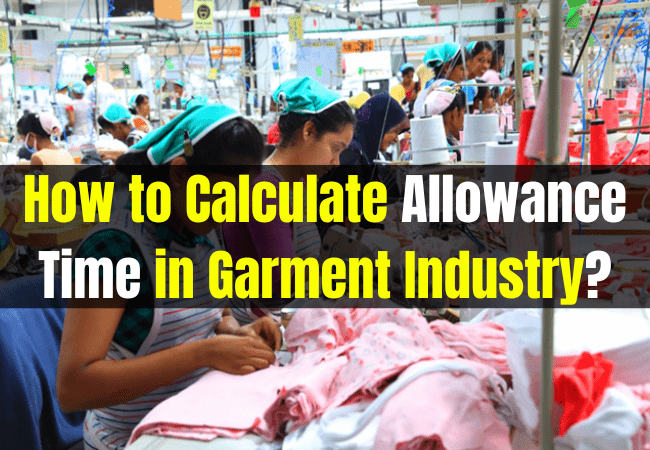Allowance Time in Garments Industry:
A worker cannot and does not work continuously throughout her full working hours in apparel manufacturing industry. She has to open a bundle, tie it up, go to lavatory, take out bobbin case, replace a blunt needle, talk to the supervisor or line inspector, a small rest to recover from fatigue, etc. She cannot avoid doing all these things, because they are beyond her control. She needs some time for her own personal needs.
This is why workers are entitled to some type of extra time for these types of circumstances in readymade garments sector. This type of time allowed to operators for some unavoidable but non-performing task is called allowance. The allowance time ranges from 15-25 %. Allowance time is taken into account during setting up of Standard Time.

Types of Allowances in Time Study:
There are different types of allowances in industrial engineering, namely:
- Relaxation allowance,
- Contingency allowance
- Machine delay allowance,
- Style change allowance
- Special allowance, etc.
All the above types of allowance have explained in the below:
1. Relaxation allowance:
It is the time allowed to an operator to attend to personal needs and to recover from fatigue. Fatigue is a mental or physical exhaustion developed in a worker due to continuous work. It is assumed that a small rest or pause in work lessens fatigue and as a result the person is re-energized.
There are two types of relaxation allowances:
- Fixed relaxation This article has answered an important question of . Hope it will help. &
- Variable relaxation allowance.
The above two types of relaxation allowances have explained in the below:
Fixed Relaxation Allowance:
Fixed allowance comprises time allowed for personal needs and for basic fatigue. Time allowed for personal needs is around 5-7 %.
Variable allowance:
Variable allowance is added to take into account a poor working condition leading to higher stress and fatigue.
2. Contingency allowance:
There are some factories which encounter frequent minor interruptions. They cover them by a contingency allowance.
3. Machine Delay Allowance:
This is the time allowed for delay due to machine maintenance. Allowance time varies with the complexity of the machine. Some typical machine delay allowances are shown below for reference:
SL No. | Type of Machine | Allowance Rate in % |
01 | 1-needle lockstitcher | 9% |
02 | 2-needle lockstitcher | 14% |
03 | 1-needle 3-thread | 7% |
04 | 2-needle 4-thread | 9% |
05 | 2-needle 5-thread | 11% |
4. Style Change Allowance:
Allowance time is permitted where frequent style changes occur.
5. Special allowance:
Sometimes, special time is given as start time allowance, shut down allowance, cleaning allowance, etc. because time is wasted at start time or change of work shift. These times are covered by special allowance.
Allowance Time Calculation in Apparel Industry:
Example:
A job comprises following elements. The work is done with a lockstiticher equipped with auto thread trimmer. There are 50 pieces in the bundle. Calculate allowance time.
SL No. | Description | Basic Time | Machine Used | Occurrence Rate | Allowance Rate |
01 | Grip the part & | 20” sec | Manual | 1 | 12% |
02 | Sew / Run stitch | 29” sec | 1-needle Lockstitcher | 1 | 9% |
03 | Turn | 15” sec | Manual | 1 | 12% |
04 | Top stitch | 25” sec | 1-needle lockstitcher | 1 | 9% |
05 | Tie up bundle | 50/50 | Manual | 1 | 12% |
Here,
Machine delay allowance time comprises SI # 2 & 4 and Personal need & Fatigue allowance comprise SI# 1, 3 & 5.
Thus Machine delay allowance = (29 +25) x 9% = 54 x 9% = 54 x 0.09 = 4.86 sec.
Thus personal needs & Fatigue Allowance (20 + 15 + 50/50) x 14% = 5.04 sec
Total Allowance time =4.86 + 5.04 sec
Standard Time for the operation Basic time + Allowance time = 90 +9.9 =99.9 sec
However many factories accept an average rate of allowance to apply to the Basic time.
In this case Standard Time Basic Time + Allowance = 90-90 X 15% -90+13.5 =103.5 sec if average allowance rate is fixed at 15%.

Mayedul Islam is a Founder and Editor of Garments Merchandising. He is an Expert in Garments Merchandising. Writing is his passion. He loves to write articles about Apparel, Textile and Garment Washing specially on Merchandising. Mail him at mayedul.islam66@gmail.com


Taking all the allowances into consideration, the expected work load can be 70 to 75% depends upon the nature of job and this will give an idea and to remove the ambiguity of deciding the allowances. This is normally followed by many Industrial engineers and 5% plus or minus does not make any major differences.
Again the short length stitching does not get the speed factor which is also another important thing is to be considered. Bundle opening, arranging and tying the buldle the time is added to the stitching operation of the bundle. This is a perfect thing which is followed by many garment industry.